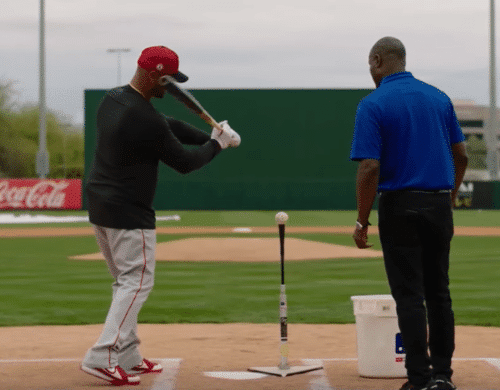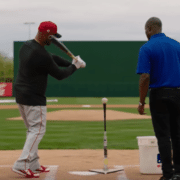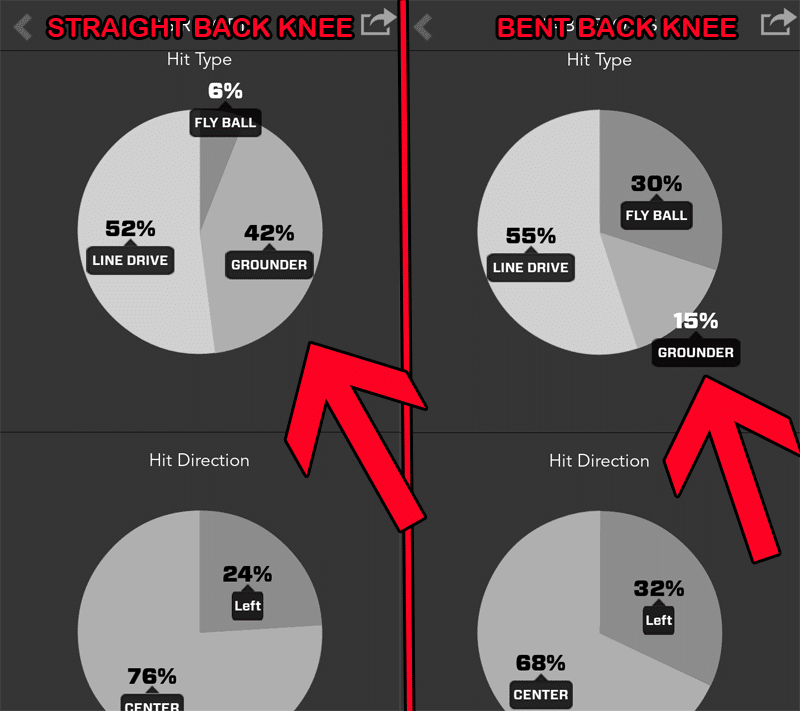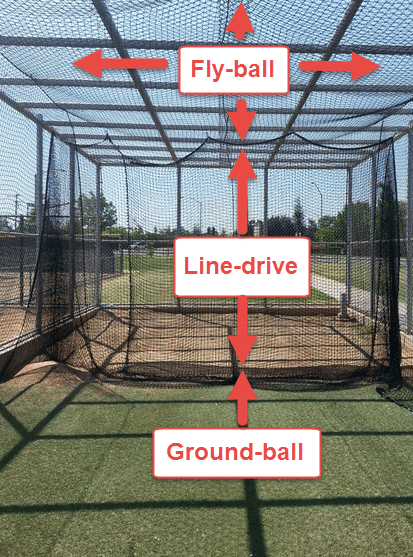Watch Albert Pujols talking about how to teach swing drills off hitting tee, place hitting outside pitches to opposite field vs pull, and keeping the hands inside out for baseball, slow-pitch, and fast-pitch softball players.
Albert Pujols Hitting Mechanics Video Talk
In this Albert Pujols hitting mechanics talk, some questions Pujols and Harold Reynolds answer:

Albert Pujols & Harold Reynolds Interview, MLB Network 30 Clubs in 30 Days. Photo courtesy: MLB.com
- Hitting ball off same spot off tee or vary?
- Dangers of a purely opposite field approach…
- When is using ‘hands inside the ball’ okay?
- Hit top part of the cage of the back?
- How many swings until you should take a break to reflect?
- Inside pitch barrel path: is it different than away?
- Should hitter get “taller” to hit a high pitch?
Make sure you watch the 8-minute 30-Clubs in 30-Days Albert Pujols interview on grooving his swing, before diving into my notes. I time stamped the above video for quick and easy reference…
- At the 0:10 second mark, tsk, tsk…notice Harold Reynolds isn’t following the 4-foot social distancing rule!! (for those watching this well after the craziness of the Coronavirus has passed – lol).
- At the 0:30 second mark, interesting Pujols talks about building a consistent swing, hitting off the tee in one spot. He references variance training with some hitting coaches moving the ball up and down, in and out. I do agree with him, but it depends on the end result. If you’re just introducing a new hitting mechanic, then keep the tee in one spot. If you’re looking to deeply embed a well worn hitting mechanic, then variance or chaos training is key.
SCIENCE-BASED TRAINING:
Improve your hitting strategy dramatically by applying human movement principles.
Learn not only how and what to train but also the science behind the methods.
- At the 0:45 second mark, Albert Pujols talks about setting tee up slightly off center of the plate towards outer part. He likes to work gap to gap and not force or push the ball to right field. He mentions if he focuses too much on right field, then he gets under the ball too much.
- At the 1:30 minute mark, Pujols dispels the myth of “staying inside the ball”. He says of course you’re inside the ball…you don’t see hitters EVER getting their hands outside the ball. ‘Hands inside the ball’ can be a great cue for those hitters doing the opposite – casting barrel early. It’s not a perfect cue, but may work in some cases. Then to throw gas on the fire, he mentions ‘knob to the ball’. Real v. Feel. There’s a reason you keep hearing this kind of stuff from guys like Pujols, A-Rod, and Bonds. It has to do with top hand dominance and pronation. We call it the “wrist snap”.
- At the 2:00 minute mark, Albert Pujols talks about working on the liner, not trying to hit the top part of the cage. He picks a spot in the cage he wants the ball to travel. External cue. He wants the ball to come off the bat as high as the tee is set. Harold brings up that some people are teaching to hit the top of the cage (I used to be one of them!!). But Albert plays the politician and comments that he doesn’t want to say what those coaches are doing is wrong, but that he wouldn’t teach that. And right now, I’d agree with him.
- At the 3:00 minute mark, Harold asked Pujols if there’s a rhythm to working on gapping the ball, and Pujols says he tries to hit 3 or 4 in a row, then take a break to reflect on the feeling. He tries not to rush when working out. He tries to take his time. Process what he just did. Great advice!
- At 4:00 minute mark, Harold asks Albert about his inside approach. How to hit the inside pitch. Watch how Pujols demos his barrel path to get to it … barrel above hands? This Adam Eaton video reveals the same thing. Interesting huh? We call this knocking the “belly button” catcher’s glove off. He says he’s just reacting to the inside pitch. Typically, he’s looking out over the plate. He doesn’t try to focus on one area of the plate. He looks middle, then adjusts in or out from there. Definitely works for Albert. And Mike Schmidt
also talked about it in his book the “Mike Schmidt Study”. Only downside is when pitchers start using EV tunnels Perry Husband talks about. It’s easier to cover middle in/out/up/down (50% of the plate), based on pitcher’s pattern. Obviously, this is more effective the better the pitcher is.
- At 5:00 minute mark, in the above Albert Pujols hitting mechanics video, Pujols talks about keeping his shoulders “square” or keep front shoulder pointing at “400-foot” mark in straight center. Not to close shoulders off. Albert never really did ‘show numbers’ much, but he does a lot of other things right.
- At 6:00 minute mark, Pujols talks about not getting “taller” to get to the pitch up in the zone, but to stay sink down and use hands to get to it. Again demonstrates keeping barrel above hands. We talk about getting shorter and staying shorter. And middle in, middle up pitches are addressed by knocking off belly button catcher’s glove or telling hitter to keep barrel above hands. Real v. Feel. Now, this isn’t actually what’s going to happen. The result of this hitting cue is a tighter, shorter, more compact barrel path. Much needed closer the ball is to the hitter or the eyes. He talks about using his legs to get to pitches down in the zone.








